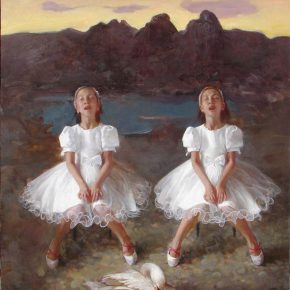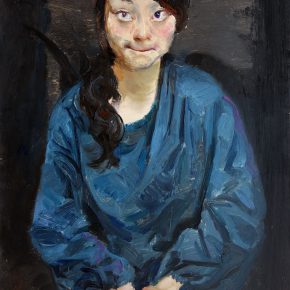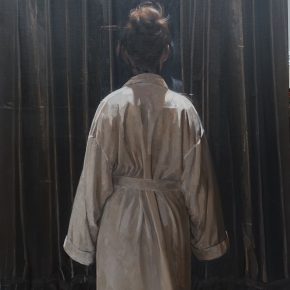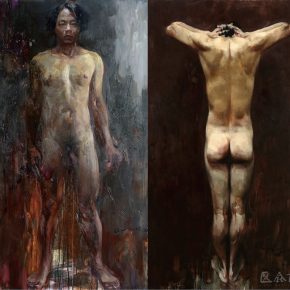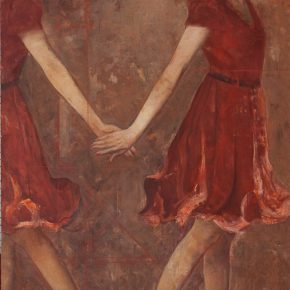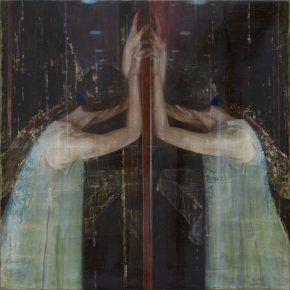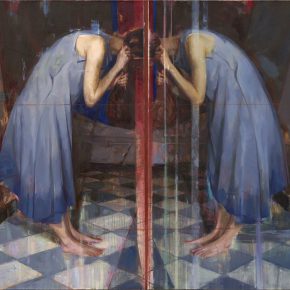
Ma Lei, Two Flowers No.3, oil on canvas, 146 x 200 cm
Born in Zibo City, Shandong Province in 1973, Ma Lei is a doctoral graduate of Central Academy of Fine Arts in 2017, and he was admitted to the Department of Oil Painting, Shandong University of Arts in 1992, and studied in Shandong University of Arts for a master’s degree from 2003 to 2006, learning from Prof. Wang Like, and he has remained on the school staff since he graduated. In 2014, he became a doctoral student majored in the oil painting at the Central Academy of Fine Arts, learning from Prof. Ding Yilin. Ma Lei, who is gradually maturing on the path of art, expresses his personal inner aesthetic needs with 4 graduation creations in different materials, which can be regarded as a periodical creative summary of his recent years.
Interview Time: May 30, 2017
Interviewee: Ma Lei (hereinafter referred to as Ma)
Interviewer: Du Mengqian (hereinafter referred to as CAFA ART INFO)
Editor: Lin Jiabin
Translated by Chen Peihua and edited by Sue/CAFA ART INFO
“In my opinion, the images of many artists’ works are actually a self-projection, and the work does not only present the relationship between the painter and the world but also an interpretation of the self. Maurice Merleau-Ponty called the ambiguous state intertwining the artist and the world “the Flesh of the World”, the image of the work is not only an objective material existence, but also unavoidably reflects the survival experience and life status of the creator.
CAFA ART INFO: Is this graduation creation a continuation of your previous artistic creation?Ma: The graduation work does not repeat the previous works in form though it is one of the results of my research. My works created in the past 4 years should be said to be the experiment and preparation for this graduation creation and the graduation creation also has some sustainability in the future.
CAFA ART INFO: What is the source of inspiration for the graduation creation of “Two Flowers” series and “The Virtual Space – Elevator”?Ma: It was mainly from my experience in survival. It is like my favorite Kafka, everyone’s artistic creation is different, and probably because I am middle aged, I am especially concerned with the “duality” of human in creation. I pour out and release some hidden emotions in the work, which are combined with the state of a natural human that creates a complete me.
CAFA ART INFO: You have tried different materials on the screen, for example, the traditional oil on canvas, mixed materials and tempera on board, why did you choose this material?Ma: I have always thought that technical things are not the most important ones, but the material is indeed very important. I have learnt to draw some paintings in tempera when I was a visiting scholar of Prof. Zhang Yuan, and “Two Flowers No.1” is the first work that I used tempera to formally create. In the process of drawing, I mainly considered how to bring the characteristics of this material into play.
CAFA ART INFO: What is the creative process of the work? What kind of working method is used?Ma: Some elements of the previous creation are continued, for example, female themes. It is certain that I illustrate women from the perspective of a male, but I prefer to use a “self-projection” approach to deal with female themes. The female is symbolic in my work, with a fragile, sensitive, hidden sense, which is interesting. In the working method, the first step is to look for models with an idea in mind. Secondly, it is to find the right scene to take pictures and the photo is my first source of creation. In the conception stage, I have many ambiguous ideas around how to use the model for interpretation is particularly important.
CAFA ART INFO: What is the position of “female” in your work?Ma: It is actually a “self-projection”, which not be easy to express clearly. I would like to express neither feminism, nor chauvinism, I prefer to focus and convey a part of the contents of my heart, what exists in everyone’s heart, while the sensuality and mystery reveals a breath of depression.
CAFA ART INFO: Why did you choose a processing method that hides women’s faces in your works?Ma: I have never considered this question, perhaps it is because I refuse to interpret personality, once the face appears it illustrates a person, and even the personality. I want to find the Gothic beauty – being noble, dark including the sex and death which is mixed with a melancholy temperament. Hiding the face is just a way now, and I have to start looking for my symbol of the “face” as the next step.
CAFA ART INFO: “Image” seems to be a very important element set in your work, which contains the understanding of your sense of space and time?Ma: In fact, the images of the paintings are all illusory, and when I present an image in the virtual space people have to determine what is real and what is unreal? It forms a mystery although I do not deliberately trick it. I am simply fascinated with the mystery, where I have self-release and exploration. The two symmetrical images are actually both virtual, and the audience can carefully find that the entity is a reflection while the reflection has become the illusory of the illusory.
CAFA ART INFO: The hidden faces, symmetrical composition, and the juxtaposition of the real and unreal space create a sense of alienation in the paintings, where is this sense of alienation from?Ma: The majority of the paintings of Giotto and Francesca took the composition as the central axis, which is like the central axis obsessive-compulsive disorder appearing in “The Grand Budapest Hotel” by Wes Anderson, relying on my understanding it is solemn and full of ritual form, which is especially in line with my aesthetic needs. This serious religious ritual sense also offers me metaphysical influence.
In addition, I have adored Pre-Raphaelite Brotherhood for many years. But I am not satisfied by depending on literature. Pre-Raphaelite Brotherhood reveals the emotion of the end of the century, and the psychological situation is particularly in line with the current state of mind.
CAFA ART INFO: You have talked about the “Picture of Dorian Gray” by Oscar Wilde, what do you think is the inner relationship between this novel and your work?Ma: The absurd, fantastic and slightly mysterious is my personal aesthetic orientation, and I love it for no reason. For example, Kafka gave me an enlightenment so that I become a complete person through the combination of the state of a natural person and the things that I express in the works. I also have the composition of Kafka, for I am both a teacher of the university and a student, being humorous and cheerful in my daily life, but with some inner secrets and repressive things are exposed in the works. People can find and complete themselves through the creation, studying a problem is to study the self.
CAFA ART INFO: How do you understand the relationship between “realism” and “performance” in your work? How do you treat “portrait”?Ma: I attach great importance to the self-portrait in the history of art, and I have no idea why many artists had the courage to face self-portraiture, for example, Rembrandt. In fact, I have also painted a nude self-portrait entitled “Forty Years Old” when I was forty years old, but I still lacked their courage and inevitably beautified my body.
There is a thin red line of the “Two Flowers No.2” and it appears in the middle of the screen without any reason, when the red line is sealed, other things must move backwards, and the three-dimensional space is deepened. The similar struggle between realism and performance is necessary, and it makes me face the game between the image and natural materiality.
CAFA ART INFO: You have studied in Shandong University of Arts for a master’s degree and then remained on the school staff after you graduated, why did you think of registering for an examination to be a doctoral student that majored in oil painting from the Central Academy of Fine Arts?Ma: I have encountered many problems in the long-term art practice, which were hard to solve through my personal efforts, so I needed some external force.
CAFA ART INFO: How do your mentors influence your creation?Ma: First of all, I have to mention my graduate tutor Wang Like who is the President of Shandong University of Arts, who gave me an important thing which is the attitude towards a painting: a painting is started and finished with a rational participation step by step.
When following my mentor Prof. Ding Yilin to study, he gave me very specific guidance. On the other hand, when I elaborated my own creative ideas, he reminded me to ascend from the prevailing problems, to think of it from the perspective of the times, to analyze it from the perspective of human nature, which is the quality of an excellent artist. Prof. Li Jun is my dissertation supervisor, he guided me to read many books on the thoughts of artistic ideas. I am particularly grateful to these mentors.


